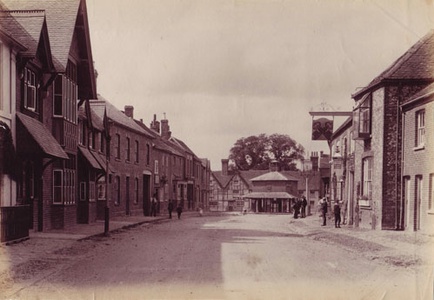| Method | Albumen Photograph |
| Artist | Henry Taunt |
| Published | c. 1890 |
| Dimensions | Image 136 x 195 mm |
| Notes |
General view along the High Street towards the Market Place with the Market House visible in the distance. Henry Taunt was born William Henry Taunt in St Ebbe's, Oxford, in 1842, the son of a plumber and a domestic servant, he reversed the order of his forenames in adult life and became Henry William. His schooling was brief and he worked for several years before joining the Oxford photographer, Edward Bracher, in 1856. He set up his own photographic business Taunt & Co in 1868 and ran it until his death at the age of 80 in 1922. His firm took more than 60,000 photographs during that time, creating an unrivalled record of Victorian and Edwardian Oxford and Oxfordshire and the River Thames from source to sea. Henry Taunt's black and white photographs consist primarily of views of Oxford, (together with surrounding counties) and the River Thames. The producer of the first ever guide book of the Thames to be illustrated with photographs Taunt played a vital part in establisihing the river as an area for recreation after the Thames above London lost most of its freight traffic to the increasing rail network. Jerome K. Jerome's novel, 'Three Men in a Boat', reflects this change from haulage to leisure which Taunt help establish through his photographs, books and illustrated lectures. Photographing the river, or indeed anywhere, in the 1860's was an extremely complex task. The wet collodion process, invented by Frederick Scott Archer, was the best means to capture negative images on glass until the end of the 1870s and required the plates to be prepared, exposed and processed while the emulsion was still damp. The process required Taunt to row his skiff to a location, set up his dark tent, set up his camera and tripod, sensitise and coat the glass plate, immediately make the two or three second exposures, develop and fix the images, wash them in river water, dry them and then row back to his lodgings or set up camp with his assistants. Henry Taunt was at the cutting edge of Victorian location photographic technology. In Henry Taunt's life-time the population of Oxford grew from around 24,000 to 57,000. It was a period of momentus change of which Taunt was there to document. Brought up in St. Ebbe's, he had a real interest in recording the less picturesque corners of Oxford; as a commercial photographer proud of his city, he also responded to the growing demand for photographs and later postcard views of Oxford's architectural treasures. A prolific local historian, he published over 50 books on Oxford and its surrounding area. Interestingly Taunt was well aware of the value of his work as a historical record: "All photographs have some limited historical value; those taken today will many of them be much wanted in fifty years time" (1918, quoted in S Read, Berkshire in Camera). In 1893 he was elected Fellow of the Royal Geographical Society, possibly in belated recognition of his New Map of the Thames first published 20 years earlier. Taunt dedicated his life to photography, but his numerous publications demonstrate his varied interests. He was typical self made Victorian, rising from humble begginings to become a true entrepreneur. A brilliant self-publicist and showman, he gave his occupation in the 1891 census, while resident in Broad Street as 'Artist in water colours, photographer, author, designer, lecturer, lantern-slide maker, picture-frame maker, gold-blocker and printer, publisher, mount cutter, ornmamental card maker, entertainer, gilder'. Taunt stock number 8520 and stamp on verso. |
| Framing | unmounted |
| Price | £60.00 |
| Stock ID | 24212 |

